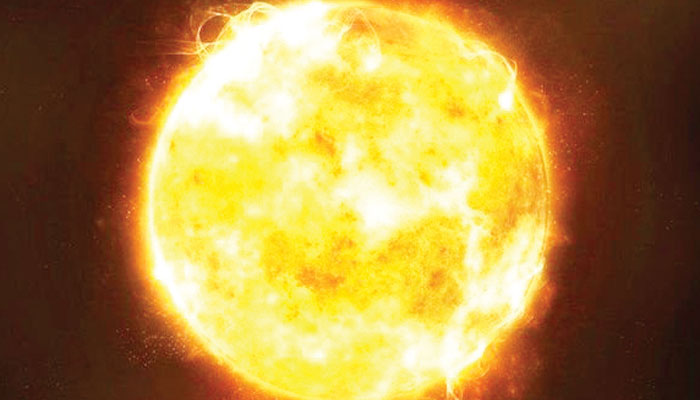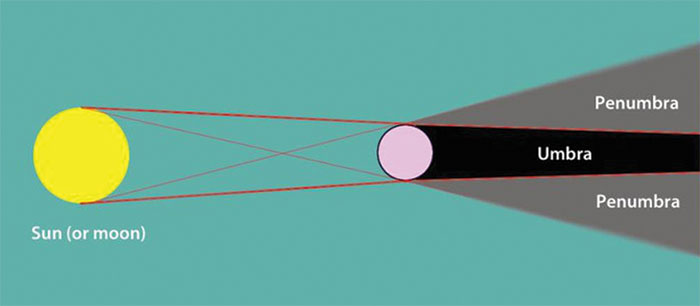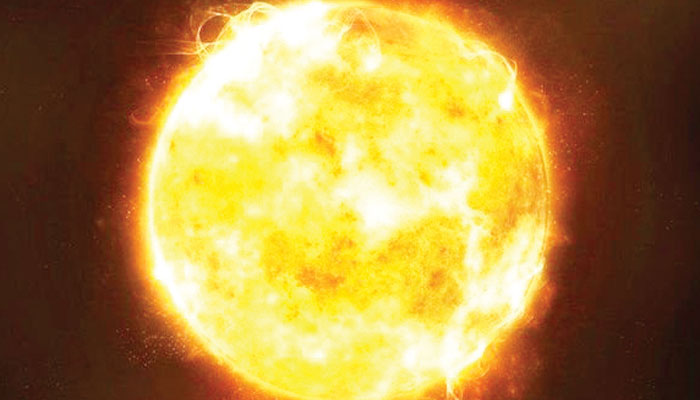
NASA’s Solar Dynamics Observatory captured samples on the Sun’s surface. Seen in ultraviolet light, these dark spots are known as coronal holes and are regions where the strong solar wind blows into space. Dark spots on the surface of the sun, known as sun spots. Although they look like freckles on the face of the Sun, they can be much larger than Earth.
Sunspots are areas where the magnetic field is about 2,500 times stronger than Earth’s, which is greater than anywhere else on the Sun. Due to the strong magnetic field, the magnetic pressure increases while the pressure of the surrounding atmosphere decreases. This results in a lower temperature than its surroundings, as the concentrated magnetic field prevents the flow of hot, new gas from the Sun’s interior to the surface. Sunspots occur in pairs in which the magnetic fields point in opposite directions.
A typical spot consists of a dark region called the umbra, surrounded by a lighter region. which is called the penumbra. Sunspots appear relatively dark, because the surface around the Sun (the photosphere) is about 10,000 degrees F. While the umbra is about 6,300 degrees F. Sunspots are large enough, as mentioned above, to be larger than Earth. Our sun is the star around which the earth and other parts of the solar system revolve. The sun is an enormous source of energy, part of which provides the Earth with the light and heat necessary to support life.
The Sun is located at the center of the Solar System, where it is the largest object by far. It makes up 99.8 percent of the Solar System and is about 109 times the diameter of Earth – about one million Earths could fit inside the Sun. The Sun’s surface is about 10,000 degrees Fahrenheit hot, while the core reaches temperatures of more than 27 million degrees Fahrenheit, caused by nuclear reactions.
The Sun is one of over 100 billion stars in the Milky Way. It orbits about 25,000 light-years from the galactic center, completing an orbit every 250 million years or so. The Sun is part of a generation of stars known as Population I, which are relatively rich in elements heavier than helium. An older generation of stars is called Population II, and an earlier generation of Population III may exist, although no members of this generation are yet known.

The Sun was born about 4.6 billion years ago. Many scientists believe that the Sun and the rest of the Solar System are made up of a large, swirling cloud of gas and dust called the “solar nebula.” As the nebula collapsed under its own gravity, it rapidly rotated and flattened into a disk. Most of the material was drawn towards the center to form the Sun. The Sun has enough nuclear fuel to last another 5 billion years from now. It will then swell to become a red giant.
Eventually, it will shed its outer layers, and the remaining core will collapse to become a white dwarf. Gradually, the white dwarf will fade away, and enter its final phase as a dim, cool theoretical object known as a “black dwarf”. The core extends from the center of the Sun to about a quarter of the way to its surface. Although it makes up about 2 percent of the Sun’s mass, it is about 15 times as dense as lead and contains about half the Sun’s mass. Next is the radiative zone, which extends 70 percent of the way to the Sun’s surface, making up 32 percent of the Sun’s volume and 48 percent of its mass. Light from the core is scattered in this zone, so that it often takes a million years for a photon to pass through.
The core is the innermost layer of the Sun and the source of all energy. Nuclear reactions are constantly taking place here. A nuclear reaction involves both fission (splitting of atoms) and fission (joining of atoms) reactions and these reactions produce a lot of energy. The core makes up 20 percent of the inner layers of the Sun. The temperature of this layer is one and a half million Kelvin (1.5 million Kelvin). From here, the energy is released after the formation process and rises outward towards the surfaces above.

The radiative zone is the Sun’s second layer above the inner core. It starts at 25 percent and extends outward to 70 percent. Energy generated in the core passes through this surface and outwards. The convective zone is the outermost and thickest surface of the Sun and is 200,000 km (200,000 miles) deep. From here the light reaches the outer atmosphere of the Sun.
When there are reactions in the Sun’s core and due to high energy, the gaseous material comes from the lower surface to the top and bursts like a bubble and releases energy that reaches the entire solar system, because this bubble is very large, some are even the size of the Earth, so they release a large amount of energy. They are also called convection cells. Their duration can be from 5 to 10 minutes to 24 hours. The part of the outer surface of the sun where the temperature is relatively low, black sun spot is seen. Some sunspots are larger than Earth.
It has a temperature of 3800K, while the Sun’s surface is usually around 5800K. The outer surface of the Sun, the part we can see, called the “photosphere,” extends 400 km beyond the Sun’s outer surface. Its uppermost part is called “chromosphere”. As you move from the outer atmosphere of the sun to the inner atmosphere, it will become opaque from transparent.
Energy inside the sun comes out in the form of photons, but it takes many years for these photons to come out of the inner surface of the sun, because as they come out from the inner surfaces, the atmosphere will become denser. Due to the heat of the sun, it is made up of plasma (the fourth state of matter) or say that the sun is plasma. (Plasma contains atoms, ions and electrons)
The sun is responsible for life on earth. The first source of all life and energy is the Sun. It is located about 149 million kilometers from our Earth. Despite such a distance, we not only feel its warmth and warmth but also do different things from it. What is the heat of the sun? This heat from the sun is produced by the conversion of hydrogen atoms into helium atoms. All the stars you see in the sky have this process, but because they are far away from us, we cannot feel their warmth. But they are also spewing fire like the “Sun” itself. Since the Sun can be easily reached by our technology.
For this reason, in 2018, NASA built a “spaceship” called the “Perker Solar Probe”, which can get closer to our “Sun”, so that we can learn more about the Sun. Since our sun has a temperature of 5,000 degrees Celsius, it is almost impossible to get close to it and withstand its heat, but the metal the “spaceship” Perker Solar Probe was made of could withstand temperatures of up to 2600 degrees Fahrenheit. In the Parker Solar Probe, NASA engineers used different types of metals, which have high melting points. This spaceship was launched towards the Sun in 2018.
It is the only spacecraft of NASA which can increase its speed to about 69 thousand kilometers per hour and this is its greatest advantage. But at this time it is moving at a speed of about five hundred thousand kilometers per hour. The purpose of this spacecraft is to pass closer and closer in front of the Sun. According to NASA astronomers, Perkar Solar Probe has observed the Sun from a distance of about one million and three million kilometers, which is a record.
According to Stewart Bell, the engineer of the Parker Solar Probe, the spacecraft passed above and below this line about three times in 5 hours, from which the Sun is 130,000 kilometers away. NASA further says that in the year 2025 it should reach a distance of 7 million kilometers from the Sun. He has also dived into the sun’s most dangerous region once. Where the temperature is very high. There is a strong possibility of more revelations and secrets coming in the near future.
setTimeout(function(){
!function(f,b,e,v,n,t,s)
{if(f.fbq)return;n=f.fbq=function(){n.callMethod?
n.callMethod.apply(n,arguments):n.queue.push(arguments)};
if(!f._fbq)f._fbq=n;n.push=n;n.loaded=!0;n.version=’2.0′;
n.queue=[];t=b.createElement(e);t.async=!0;
t.src=v;s=b.getElementsByTagName(e)[0];
s.parentNode.insertBefore(t,s)}(window,document,’script’,
‘https://connect.facebook.net/en_US/fbevents.js’);
fbq(‘init’, ‘836181349842357’);
fbq(‘track’, ‘PageView’);
}, 6000);
/*setTimeout(function(){
(function (d, s, id) {
var js, fjs = d.getElementsByTagName(s)[0];
if (d.getElementById(id)) return;
js = d.createElement(s);
js.id = id;
js.src = “//connect.facebook.net/en_US/sdk.js#xfbml=1&version=v2.11&appId=580305968816694”;
fjs.parentNode.insertBefore(js, fjs);
}(document, ‘script’, ‘facebook-jssdk’));
}, 4000);*/



